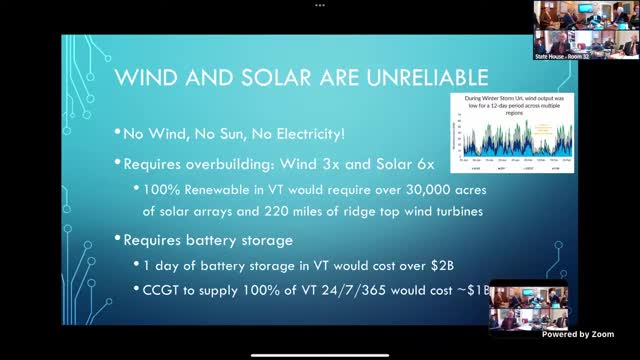Expert highlights renewable energy challenges facing MISO grid during Midwest storms
March 01, 2025 | Environment & Energy, HOUSE OF REPRESENTATIVES, Committees, Legislative , Vermont
This article was created by AI summarizing key points discussed. AI makes mistakes, so for full details and context, please refer to the video of the full meeting. Please report any errors so we can fix them. Report an error »

Vermont's energy future took center stage during a recent meeting of the House Energy and Digital Infrastructure Committee, where discussions highlighted the challenges of transitioning to renewable energy sources. A key focus was the reliance on wind and solar power, which, while promising, presents significant hurdles in terms of reliability and cost.
The committee examined data from the Midcontinent Independent System Operator (MISO) grid, revealing that the output from wind and solar can be inconsistent. This inconsistency was notably illustrated by a past storm in the Midwest, which raised concerns about the adequacy of renewable energy during extreme weather events.
To achieve a fully renewable energy system in Vermont, experts indicated that the state would need to cover approximately 30,000 acres with solar arrays and install 220 miles of wind turbines. However, this ambitious plan raises questions about land use and public acceptance, particularly regarding the extensive installation of wind turbines on ridgelines.
Additionally, the discussion underscored the necessity of battery storage to manage energy supply during periods when renewable sources are not producing. The estimated cost for just one day's worth of battery storage for Vermont's energy needs is around $2 billion, a figure that highlights the financial challenges of relying solely on renewable energy.
The committee also noted that traditional energy sources, such as gas turbine generators, remain essential for providing reliable power. The cost of these generators is significantly lower than that of battery storage, emphasizing the need for a balanced energy strategy that includes both renewable and conventional energy sources.
As Vermont navigates its energy transition, the committee's discussions reflect a critical examination of the practical implications of renewable energy goals, ensuring that the state can meet its energy demands reliably and affordably. The path forward will require careful consideration of both innovative solutions and the realities of energy production.
The committee examined data from the Midcontinent Independent System Operator (MISO) grid, revealing that the output from wind and solar can be inconsistent. This inconsistency was notably illustrated by a past storm in the Midwest, which raised concerns about the adequacy of renewable energy during extreme weather events.
To achieve a fully renewable energy system in Vermont, experts indicated that the state would need to cover approximately 30,000 acres with solar arrays and install 220 miles of wind turbines. However, this ambitious plan raises questions about land use and public acceptance, particularly regarding the extensive installation of wind turbines on ridgelines.
Additionally, the discussion underscored the necessity of battery storage to manage energy supply during periods when renewable sources are not producing. The estimated cost for just one day's worth of battery storage for Vermont's energy needs is around $2 billion, a figure that highlights the financial challenges of relying solely on renewable energy.
The committee also noted that traditional energy sources, such as gas turbine generators, remain essential for providing reliable power. The cost of these generators is significantly lower than that of battery storage, emphasizing the need for a balanced energy strategy that includes both renewable and conventional energy sources.
As Vermont navigates its energy transition, the committee's discussions reflect a critical examination of the practical implications of renewable energy goals, ensuring that the state can meet its energy demands reliably and affordably. The path forward will require careful consideration of both innovative solutions and the realities of energy production.
View full meeting
This article is based on a recent meeting—watch the full video and explore the complete transcript for deeper insights into the discussion.
View full meeting